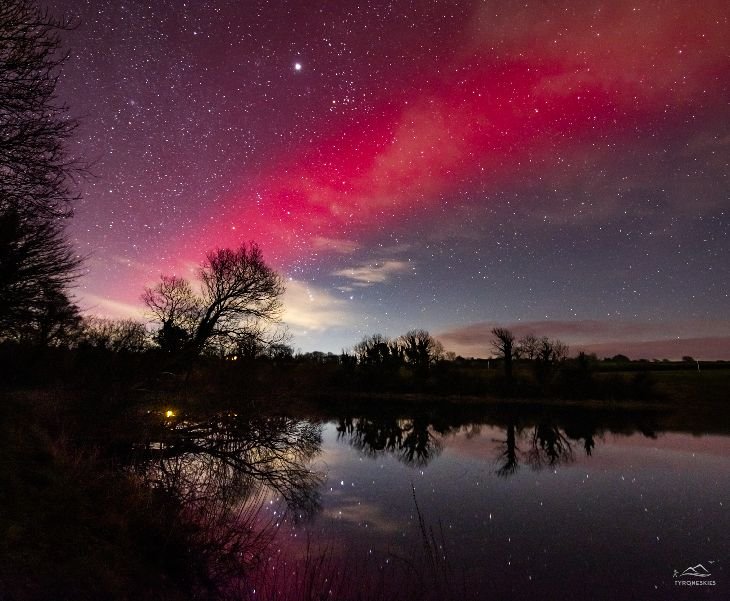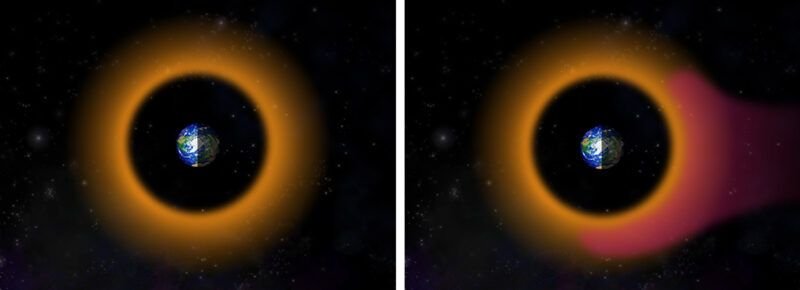Not an Aurora?

Many throughout the world were able to experience another great evening of auroras on New Year’s Day 2025. However, there’s a catch, some actually saw what are known as SAR arcs. These were first discovered in 1956. Researchers weren’t sure what they were and gave them the misleading name, Stable Auroral Red arcs.
You see, arcs aren’t auroras. SAR arcs are generated by extreme thermal and kinetic energy in Earth’s atmosphere. On January 1st, the ring current was pumped up by hours of very intense geomagnetic storming and that energy dissipated down into SAR arcs. Normally, human eyes are unable to detect them because we’re not very sensitive to the 630 nm wavelength. However, that’s not a problem for cameras.

During periods when there are no geomagnetic storms affecting the area around Earth (left image), high-energy protons (with energy of hundreds of thousands of electron volts, or keV; shown here in orange) carry a substantial electrical current that encircles the planet, also known as the ring current. During periods when geomagnetic storms affect Earth (right), new low-energy protons (with energy of tens of thousands of electron volts, or keV; shown here in magenta) enter the near-Earth region, enhancing the pre-existing ring current. Credits: Johns Hopkins APL
This was captured in Utah. You will notice that the “arc” does not move as auroras do, but is stable, making it easier to spot.
Okay, so now you want to know about STEVE, right? Let me introduce you to him. As you’ll discover, he’s kinda shy and doesn’t show his face very often.
Strong Thermal Emission Velocity Enhancement — is an aurora-like glow that often accompanies the northern lights yet is a distinct phenomenon. STEVE was discovered between 2015 and 2016, by citizen scientists in Canada chasing the aurora. STEVE is a streak of purplish light in the night sky that’s similar to an aurora. In fact, STEVE has only ever been observed in conjunction with an aurora.
As you know, when energized particles from the sun crash into Earth, our magnetic field redirects the particles toward the north and south poles. The process is similar to how neon lights work: When the molecules and atoms get “excited” by electrons, they must return to their original energy (ground state) and do so by releasing the energy as photons (light). At the same time, some of these solar emissions (in the form of super-speedy streams of plasma) heat gas in the upper atmosphere, and that’s what creates STEVE. So yes, similar to the phenomena, SAR arc.
Also, STEVE occurs at lower latitudes than the aurora, meaning you can see it farther south such as in southern Canada, southern Alaska, northern Europe, New Zealand, and Australia. So, many people have a chance to see STEVE without traveling up north, according to Toshi Nishimura, (Research Associate Professor, Boston University’s College of Engineering). And based on our current knowledge of STEVE, your best chance to see it would be during a major geomagnetic storm — the same type of storm that produces vibrant aurora. Nishimura notes that the odds are stronger in the fall and the spring, sometime before midnight. But STEVE is still a relatively rarely spotted phenomenon. So far, it has only ever been seen in conjunction with the aurora.

Leave a Reply
You must be logged in to post a comment.